
“What about pangolin music?”
We’ve got you covered! Eleven pangolin-themed songs for 40 minutes of music to enjoy on World Pangolin Day (or any day)!
Theme: Pangolins (name of song or band), pinecone, artichoke, and … roll up.

We’ve got you covered! Eleven pangolin-themed songs for 40 minutes of music to enjoy on World Pangolin Day (or any day)!
Theme: Pangolins (name of song or band), pinecone, artichoke, and … roll up.

This heart-covered pangolin is wishing everyone a Happy Valentine’s Day!

World Pangolin Day is celebrated on the third Saturday in February, and this year, the special day falls on February 20, 2021!
World Pangolin Day day is an opportunity for pangolin enthusiasts to join together in raising awareness about these unique mammals — and their plight. Pangolins are unfortunately one of the most heavily trafficked mammals in the illegal wildlife trade.
Everyone is invited and encouraged to participate in World Pangolin Day! The aim of World Pangolin Day is to draw as much attention to pangolins as possible, since they are still relatively unknown outside of Africa and Asia.
Pangolins, also known as scaly anteaters, are unique creatures that are covered in hard, plate-like scales. They are insectivorous (feeding nearly exclusively on ants and termites) and are mainly nocturnal. Their name, “pangolin”, is derived from the Malay word “pengguling”, which loosely translates to “something that rolls up”. Together, the eight species comprise their very own Order: Pholidota.
There are a total of eight species of pangolin on our Planet, and all pangolin populations are declining, due to the illegal trade for meat (it’s considered a delicacy in China and Vietnam) and scales (used in traditional Chinese medicine, despite no evidence of medicinal properties).
Four pangolin species live in Asia:
Four pangolin species live in Africa:

World Pangolin Day is celebrated on the third Saturday in February, and this year, the special day falls on February 15, 2020!
World Pangolin Day day is an opportunity for pangolin enthusiasts to join together in raising awareness about these unique mammals — and their plight. Pangolins are unfortunately one of the most heavily trafficked mammals in the illegal wildlife trade.
Everyone is invited and encouraged to participate in World Pangolin Day! The aim of World Pangolin Day is to draw as much attention to pangolins as possible, since they are still relatively unknown outside of Africa and Asia.
Pangolins, also known as scaly anteaters, are unique creatures that are covered in hard, plate-like scales. They are insectivorous (feeding nearly exclusively on ants and termites) and are mainly nocturnal. Their name, “pangolin”, is derived from the Malay word “pengguling”, which loosely translates to “something that rolls up”. Together, the eight species comprise their very own Order: Pholidota.
There are a total of eight species of pangolin on our Planet, and all pangolin populations are declining, due to the illegal trade for meat (it’s considered a delicacy in China and Vietnam) and scales (used in traditional Chinese medicine, despite no evidence of medicinal properties).
Four pangolin species live in Asia:
Four pangolin species live in Africa:
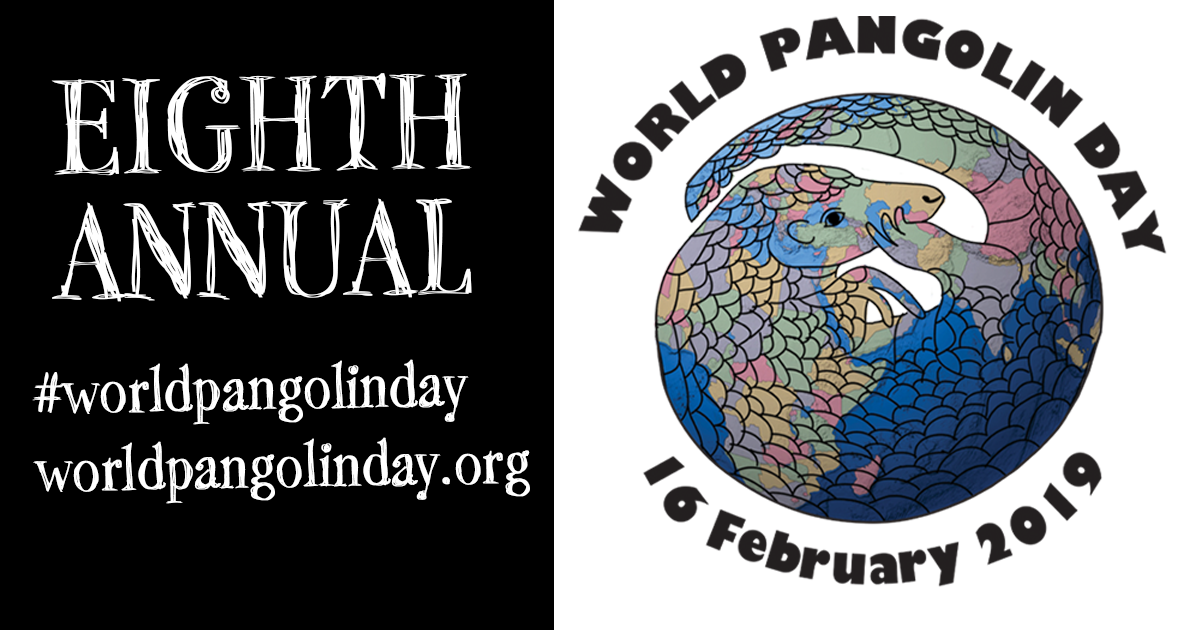
World Pangolin Day day is an opportunity for pangolin enthusiasts to join together in raising awareness about these unique mammals — and their plight. Pangolins are unfortunately one of the most heavily trafficked mammals in the illegal wildlife trade.
Everyone is invited and encouraged to participate in World Pangolin Day! The aim of World Pangolin Day is to draw as much attention to pangolins as possible, since they are still relatively unknown outside of Africa and Asia.
Pangolins, also known as scaly anteaters, are unique creatures that are covered in hard, plate-like scales. They are insectivorous (feeding nearly exclusively on ants and termites) and are mainly nocturnal. Their name, “pangolin”, is derived from the Malay word “pengguling”, which loosely translates to “something that rolls up”. Together, the eight species comprise their very own Order: Pholidota.
There are a total of eight species of pangolin on our Planet, and all pangolin populations are declining, due to the illegal trade for meat (it’s considered a delicacy in China and Vietnam) and scales (used in traditional Chinese medicine, despite no evidence of medicinal properties).
Four pangolin species live in Asia:
Four pangolin species live in Africa:

From April 18 to 20, USAID Wildlife Asia and DNP’s “Back to the Wild” workshop convened pangolin care experts and quarantine officials to increase pangolin survival rates when they are released.
The workshop, held at Khao Yai National Park, introduced police, customs officers and Wildlife Quarantine Centre staff to the most effective techniques for handling stressed or injured pangolins, including protocols for rehabilitating pangolins back into the wild. These threatened mammals have a heightened sensitivity to stress and thrive only on a natural diet and in a conducive habitat.
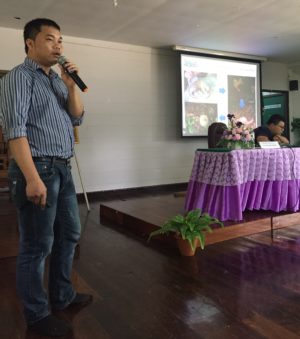
USAID Wildlife Asia invited Thai Nguyen, Executive Director of Save Vietnam’s Wildlife, to facilitate the workshop with support from Lisa Hywood, founder of Tikki Hywood Foundation. Mr. Nguyen and Ms. Hywood are recognized as leading experts with hands-on experience and proven track records of rehabilitating and releasing confiscated pangolins.
With global trends indicating an increasing number of seizures and only an estimated 50,000 pangolins still in existence, protection of this species is growing all the more important.
“This is a unique opportunity to help improve survival rates of confiscated live pangolins,” said Dr. Pinsak Suraswadi, Deputy Director General of the DNP.
“Veterinarians and staff at the Center have been able to learn how to care for and rehabilitate these incredibly vulnerable live pangolins so they can be released back into the wild.”
“Wildlife protection is a priority for USAID,” said Richard Goughnour, Director of USAID’s Regional Development Mission for Asia.
“If we can improve coordination among first responders and wildlife quarantine staff, rescued pangolins will have a chance to thrive back in the wild in Thailand, Vietnam and across Asia.”
Participants also learned how to use the USAID Pangolin Species Identification Guide: A Rapid Assessment Tool for Field and Desk, a booklet designed to help authorities confidently identify the eight species of pangolin and pangolin products.
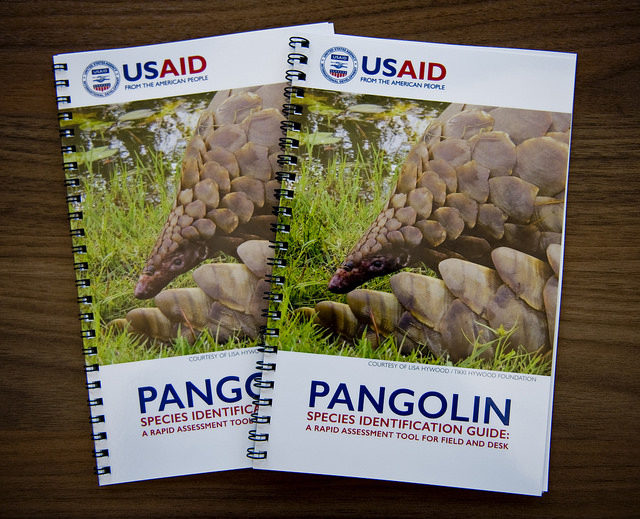
Developed by the USAID Wildlife Asia project, the Pangolin Species Identification Guide: A Rapid Assessment Tool for Field and Desk will make it easier for law enforcement officers to identify pangolins and pangolin parts — such as scales and skins — they may encounter in the field. The guide provides species identification characteristics and range maps, allowing officers to identify pangolins and their likely country of origin.
“This guide will be a great benefit for frontline law enforcement officers who work at entry ports, such as international airports, seaports and land border crossings, to effectively enforce any laws relating to pangolins,” said Pinsak Suraswadi, Deputy Director General of Thailand’s Department of National Parks, Wildlife and Plant Conservation (DNP).
In 2017, authorities seized 32 tons of pangolin scales and 563 live pangolins in Southeast Asia and China. According to recent research published in Conservation Letters, up to 2.7 million pangolins are being killed every year in Central Africa alone. In many cases seized pangolins are not identified properly, making it difficult to know the original source of the trafficked individuals.
“We have to act now to protect pangolins, as they are at high risk of extinction,” said acting USAID Regional Development Mission for Asia Director Richard Goughnour. “This guide is one important contribution to better equip law enforcement officers to succeed in fighting this crime.”
USAID Wildlife Asia gave a preview of the guide at the November 2017 Convention on International Trade in Endangered Species of Wild Fauna and Flora (CITES) Standing Committee meeting in Geneva. “The CITES Secretariat has already made the guide available on the CITES Virtual College, the World Customs Organization Environet platform, and more widely distributed it among the International Consortium on Combating Wildlife Crime partner organizations, to make it available as widely as possible to officers responsible for wildlife law enforcement in the front lines,” said CITES Secretary-General John E. Scanlon.
USAID Wildlife Asia will further support pangolin identification with plans to roll out in late 2018 an interactive smartphone application to aid law enforcement and customs officials in the identification of pangolins and pangolin products.
USAID Wildlife Asia and the DNP will use the new guide at Thailand’s first-ever pangolin husbandry workshop to train customs and relevant law enforcement authorities to improve survival and release rates of live pangolins confiscated in the illegal wildlife trade.
All eight species of pangolin, four in Asia and four in Africa, are illegal to trade and are listed in CITES Appendix I, the highest level of international protection. Thailand is home to two pangolin species, the Sunda pangolin (Manis javanica) and the Chinese pangolin (Manis pentadactyla). The primary destinations for pangolin scales and meat are China and to a lesser extent, Vietnam. Criminals frequently use Thailand as a transit point in the illegal pangolin trade.
The Pangolin Species Identification Guide is available on www.usaidwildlifeasia.org in English and Thai and will also be translated in Indonesian, Malaysian, Mandarin and Vietnamese.
About USAID Wildlife Asia
The USAID Wildlife Asia Activity works to address wildlife trafficking as a transnational crime. The project aims to reduce consumer demand for wildlife parts and products, strengthen law enforcement, enhance legal and political commitment, and support regional collaboration to reduce wildlife crime in Southeast Asia, particularly: Cambodia, Laos, Thailand, Vietnam and China. Species focus of USAID Wildlife Asia include elephant, rhinoceros, tiger and pangolin. For more information, please visit www.usaidwildlifeasia.org

World Pangolin Day day is an opportunity for pangolin enthusiasts to join together in raising awareness about these unique mammals — and their plight. Pangolins are unfortunately one of the most heavily trafficked mammals in the illegal wildlife trade.
Everyone is invited and encouraged to participate in World Pangolin Day! The aim of World Pangolin Day is to draw as much attention to pangolins as possible, since they are still relatively unknown outside of Africa and Asia.
Pangolins, also known as scaly anteaters, are unique creatures that are covered in hard, plate-like scales. They are insectivorous (feeding nearly exclusively on ants and termites) and are mainly nocturnal. Their name, “pangolin”, is derived from the Malay word “pengguling”, which loosely translates to “something that rolls up”. Together, the eight species comprise their very own Order: Pholidota.
There are a total of eight species of pangolin on our Planet, and all pangolin populations are declining, due to the illegal trade for meat (it’s considered a delicacy in China and Vietnam) and scales (used in traditional Chinese medicine, despite no evidence of medicinal properties).
Four pangolin species live in Asia:
Four pangolin species live in Africa:
For more information or media inquiries, please contact me: rhishja (at) annamiticus (dot) com
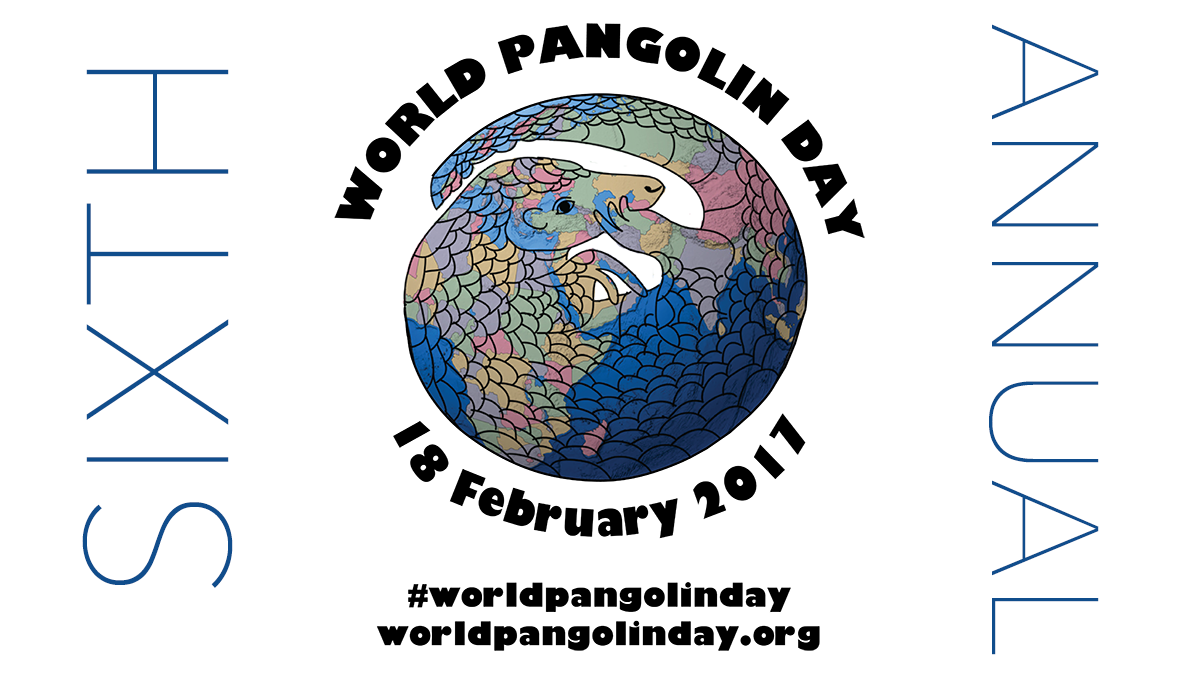
World Pangolin Day day is an opportunity for pangolin enthusiasts to join together in raising awareness about these unique mammals — and their plight. Pangolins are unfortunately one of the most heavily trafficked mammals in the illegal wildlife trade.
Everyone is invited and encouraged to participate in World Pangolin Day! The aim of World Pangolin Day is to draw as much attention to pangolins as possible, since they are still relatively unknown outside of Africa and Asia.
Pangolins, also known as scaly anteaters, are unique creatures that are covered in hard, plate-like scales. They are insectivorous (feeding nearly exclusively on ants and termites) and are mainly nocturnal. Their name, “pangolin”, is derived from the Malay word “pengguling”, which loosely translates to “something that rolls up”. Together, the eight species comprise their very own Order: Pholidota.
There are a total of eight species of pangolin on our Planet, and all pangolin populations are declining, due to the illegal trade for meat (it’s considered a delicacy in China and Vietnam) and scales (used in traditional Chinese medicine, despite no evidence of medicinal properties).
Four pangolin species live in Asia:
Four pangolin species live in Africa:
For more information or media inquiries, please contact me: rhishja (at) annamiticus (dot) com
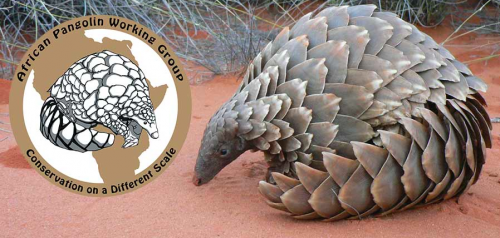
The APWG is the official African representative of the IUCN Species Survival Commission Pangolin Specialist Group and, as such, undertakes trade monitoring, research, rehabilitation, law enforcement and community projects across multiple African states. It was established in 2011 and registered with the South African Government in 2013.
“The African Pangolin Working Group is an organisation of like-minded people with a passion to conserve this rare and endangered species. Through this group we hope to bring a conscious change towards the protection of this shy and enigmatic animal – the Pangolin!”, says Lisa Hywood, Tikki Hywood Trust (Zimbabwe) and founding member of APWG.
Pangolins are hunted in Africa for bushmeat and traditional medicine. Hywood explains that African pangolins are under additional pressure as the Asian pangolin species have already been hunted to near extinction. “Africa has become Asia’s new harvesting ground to meet the insatiable demand for pangolin and their body parts.”
According to the APWG website:
Pangolins in Africa are under increasing threat from man. Every year numerous individuals are illegally exported to Asian markets while many more individuals are traded domestically, are accidentally killed on electrified game fences and on roads. The current rate of consumption is believed to far exceed the reproductive potential of the species, with the result that these species are being pushed ever closer to extinction.
At the moment, trade in African pangolins mostly goes unnoticed. The Working Group believes that public support for spreading pangolin conservation awareness is crucial for the conservation of this elusive and under-studied group of animals.
“With our official launch in February, we hope to reach a global audience to highlight the plight of these mammals and bring the world’s attention to a group of animals that face a very real extinction crisis if a concerted effort is not made to reverse their rapid decline,” said the APWG’s Co-Chairs, Darren Pietersen and Raymond Jansen.
Learn more: